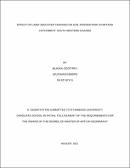| dc.description.abstract | Quantifying the response of a catchment to land use/cover change is imperative for the proper management of water resources within a catchment. River Mitano catchment has undergone significant land use/cover changes (LULC) underpinned by numerous socio-economic and environmental factors. However, its effect on soil erosion has not yet been fully recognized. This study therefore investigated the extent and transitions in land use/cover changes in the River Mitano catchment for the period 2000-2020 and the effect of these changes on soil erosion. To quantify the extent and transitions of land use/cover change in the River Mitano catchment, Landsat-7(2000), Landsat-8 (2010), and Sentinel-2A and 2B images for 2020 were obtained from United States Geologic Survey (USGS). LULC change analysis using the supervised classification of the Landsat and Sentinel images was done to reveal Land use/cover changes in the catchment for the period 2000 to 2020. To determine the effect of LULC change on soil erosion, soil erosion modeling was performed using Revised Universal Soil Loss Equation (RUSLE). Results of the LULC change revealed a decrease in grassland, wetlands, and woodland by 6.7% and 5.9%, 0.12% and 0.14%, 0.01% and 0.29% for the period 2010 and 2020 respectively. However, subsistence farming, built-up and tree plantation steadily increased by 2.96% and 3.59%, 0.70% and 2.33%, 3.14% and 0.11% for the period 2010 and 2020 respectively was detected. The major LULC transitions were the conversion of grassland to subsistence farming at a rate of 16.48% while 11.95% of subsistence farming converted to grassland for the period 2000 to 2020. Soil erosion rate varied from very high (10-500 t ha-1yr-1) with an increase of 11% and 5% for the LULC of 2010 and 2020 in the catchment. The study concludes soil erosion of the catchment was influenced by Land use/cover change through conversion of grasslands, tropical high forests and wetlands to subsistence farming which has persistently increased both soil erosion risk. Based on these findings it is recommended that there is a need to adopt soil and water conservation practices to minimize soil erosion and ensure proper protection of the River Mitano catchment. | en_US |

